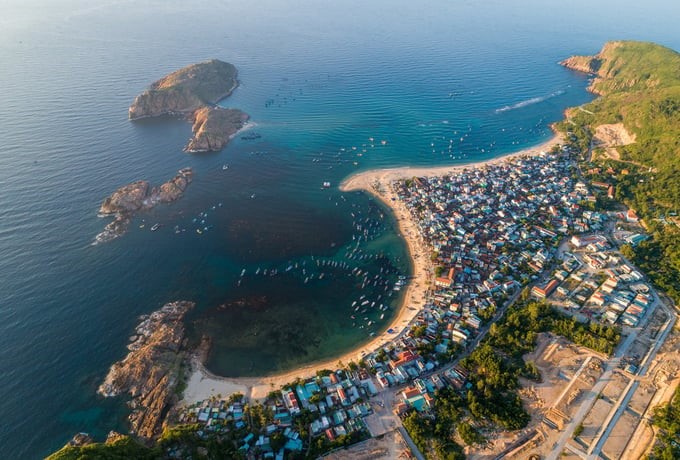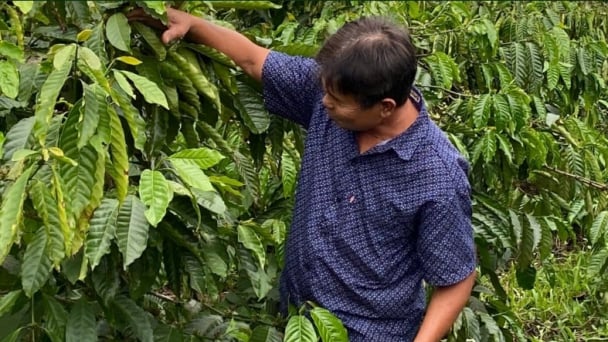June 21, 2025 | 02:20 GMT +7
June 21, 2025 | 02:20 GMT +7
Hotline: 0913.378.918
June 21, 2025 | 02:20 GMT +7
Hotline: 0913.378.918

Dong Hoi city, Quang Binh province, is on the banks of the Nhat Le River.
Among Vietnam's 28 coastal provinces and cities, 15 localities have coastlines of 100km or more, and 11 provinces are located in the North Central and Central Coast regions. Of these, the five provinces with the longest coastlines in the region are Khanh Hoa (370km), Binh Thuan (192km), Phu Yen (182km), Ha Tinh (137 km), and Binh Dinh (134km).
Therefore, in addition to rapid, sustainable development and leading the country in the ocean economy, the North Central and Central Coast regions also focus on building synchronous, modern, green, and smart infrastructure. The urban system is linked into a synchronous network with typical, rich-identity, green, civilized architecture and the ability to withstand and adapt to climate change.
By 2050, the North Central and Central Coast will develop at least 2 urban areas and a number of large industrial, service, and international cooperation centers, on par with the Asian region, in modern coastal economic zones; develop civilized, modern, green rural areas rich in national cultural identity.
At the same time, develop a good-quality environment and harmonious society where cultural and historical values and marine, island, and forest ecosystems are preserved and promoted. People's material and spiritual lives will reach a high level; national defense, security, and sovereignty over seas and islands will be firmly guaranteed.
To achieve the above goals, the planning focuses on developing ocean economic sectors; improving productivity and quality based on the application of science and technology, innovation, and digital transformation. Strongly developing a number of industries, such as the semiconductor and chip manufacturing industry; financial, commercial, and logistics services. Developing science and technology; innovation; and forming research, training, and transfer centers for new technologies such as semiconductor chips, artificial intelligence, and clean energy.
Along with that, improve the business investment environment and build specific mechanisms and policies for regional development. Complete infrastructure projects and introduce policies to encourage people to stick to the sea. Build effective renewable energy and clean energy projects in coastal areas with favorable conditions and high potential, associated with promoting tourism development and maximizing the region's advantages.
With much potential, the North Central and Central Coast regions have many factors to become key tourist areas of the country. According to the plannìng, many provinces belong to the driving area for national tourism development, including: (1) Ninh Binh - Thanh Hoa - Nghe An; (2) Quang Binh - Quang Tri - Thua Thien Hue - Da Nang - Quang Nam; and (3) Khanh Hoa - Lam Dong - Ninh Thuan - Binh Thuan.

The planning for the North Central and Central Coast regions focuses on developing ocean economic sectors and improving productivity and quality based on the application of science and technology, innovation, and digital transformation. Photo: VGP.
The North Central and Central Coast's orientation is to develop economic corridors along the North-South axis and East-West economic corridors to effectively connect seaports, economic zones, airports, international border gates, major trade hubs, coastal cities, economic centers, and growth poles.
At the same time, synchronously develop the seaport system in the provinces in the region; upgrade, renovate, and improve the operational efficiency of nine existing airports in the region.
On that basis, the region determines to participate deeply in the global value chain and build a number of large-scale industrial clusters with high international competitiveness. Increase the contribution rate of the industrial sector to the region's GRDP to about 25–35%.
Focus on industrial development along the North-South economic corridors and East-West economic corridors associated with seaports and national highways connecting to the Central Highlands. Expand the industrial distribution space to the West of the North-South Expressway East.
Develop the petrochemical refining industry and production of refined petroleum products concentrated in Thanh Hoa, Quang Ngai, Khanh Hoa, and Phu Yen; prioritize renewable energy production in Quang Binh, Quang Tri, Quang Nam, Quang Ngai, Binh Dinh, Ninh Thuan, and Binh Thuan; and build inter-regional renewable energy industrial and service centers in Ninh Thuan and Binh Thuan.
Form modern, professional logistics zones, applying advanced technology and meeting international integration requirements; form logistics centers associated with seaports, airports, and border gates. Develop regional and national logistics centers based on the regional seaport system and main international transport corridors, striving to contribute over 6% of the country's total logistics revenue.
Coastal cities are planned to be harmoniously linked with the exploitation of oil and other marine mineral resources; develop the aquaculture, seafood exploitation, and processing industries in parallel with protecting the marine environment; and develop coastal and offshore industries.
Before announcing the planning for the North Central and Central Coast regions, many provinces in the area were also determined to invest heavily in the ocean economy. For example, Binh Dinh strives to become an ocean economic center with an average GRDP growth rate of 8.5% or more in the 2021–2030 period.
The whole country currently maintains six socio-economic regions, including the Northern Midlands and Mountainous region (14 provinces), the Red River Delta (11 provinces and cities), the North Central and Central Coast (14 provinces), the Central Highlands (5 provinces), the Southeast (6 provinces and cities), and the Mekong Delta (13 provinces and cities).
Translated by Thu Huyen

(VAN) The waste of resources from agricultural by-products and the situation of counterfeit and poor quality goods in production causing losses of thousands of billions were pointed out by the National Assembly deputy.

(VAN) After 5 years of implementation, the CAI initiative has helped coffee growers change their farming practices, moving toward responsible agriculture that meets global export standards.

(VAN) The primary prerequisite for the comprehensive and robust integration of Vietnam's livestock sector into the global value chain is the establishment of a disease control system.

(VAN) The results of national programs are essential for establishing a contemporary livestock sector that is well-equipped to meet the demands of both domestic and international markets, with robust biosafety standards.

(VAN) The UNESCO Global Geopark revalidation of Non nuoc Cao Bang and the transition to a two-tier administrative model are presently undergoing a pivotal moment in Cao Bang, the northernmost province of Vietnam.
/2025/06/13/5330-2-004539_953.jpg)
(VAN) Changing policy mindset and removing investment barriers are urgent requirements to open up new development space for enterprises in the agricultural sector.

(VAN) The areas include the restoration of five million hectares of marine ecosystems.